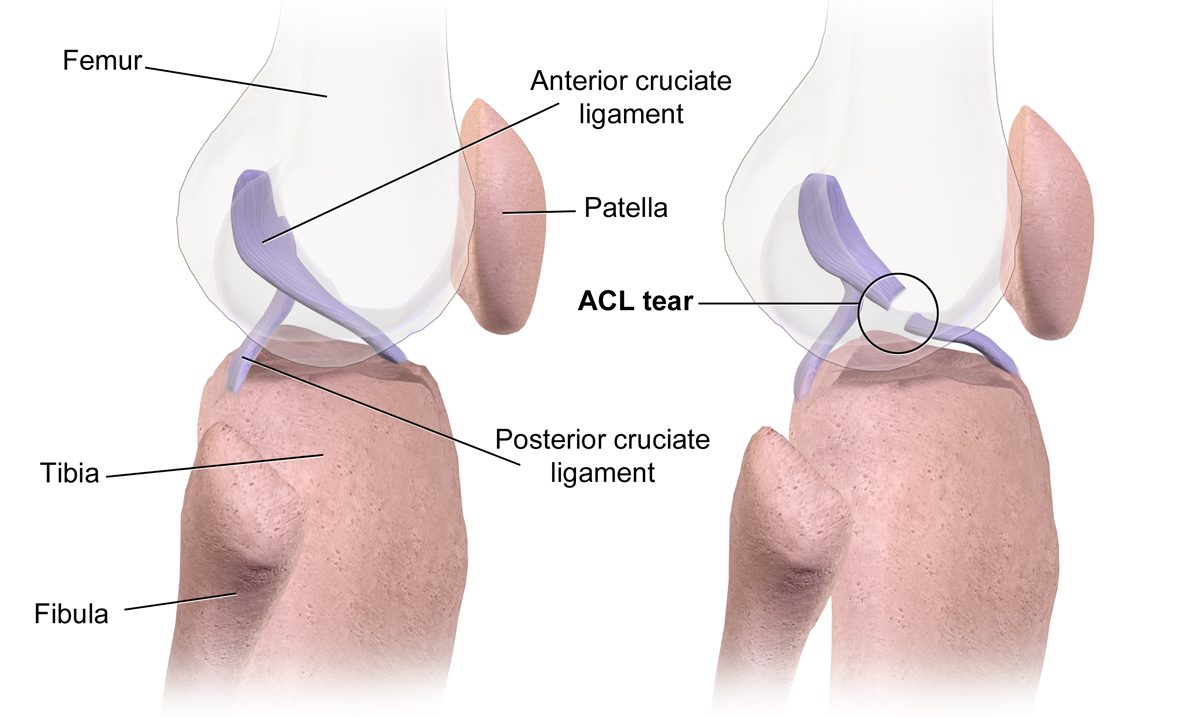Now for doctors, physiotherapists and even some athletes the letters ACL are well known, but for others these three random letters pushed together might not make any sense. So in this post I will help you find the answer to burning questions like:
- What does ACL stand for?
- Where in the body is it located?
- What does it do?
- Have I injured it?
- How can I fix it?
So, lets begin.....
What does ACL stand for?
The letters ACL stand for Anterior Cruciate Ligament, simple right? A ligament is a connective piece of tissue made up of individual fibres, slightly resembling an elastic band. Ligaments can be found in many areas of the human body and serve the purpose of connecting bones together, the Anterior Cruciate Ligament being no different. The ACL is accompanied by three other major ligaments:
- Posterior Cruciate Ligament (PCL)
- Medial Collateral Ligament (MCL)
- Lateral Collateral Ligament (LCL)
Where is the ACL and What does it do?
The Anterior Cruciate Ligament can be found in both knee joints, to be exact in the centre of both your right and left knee. Along with the Posterior Cruciate Ligament, the ACL is a ligament that attaches at the bottom of the femur (thigh bone) to the top of the tibia (shin bone) connecting both together. So now that we know where the ACL is, what exactly are the main functions of the Anterior Cruciate Ligament:
- To not allow your Tibia (Shin Bone) to move in a forward direction away from the Femur (Thigh Bone).
- The ACL helps with the stability of both knee joints, allowing you to perform turns, twists and changes of direction at high speeds.
- The ACL with the aid of the Posterior Cruciate Ligament (PCL) also prevents the knee from hyperextension.
Causes, Symptoms and Types of Injuries
Now that you have a better understanding of what an ACL is, lets create a scenario in which you were playing a sport or performing an activity and while doing this you just so happen to land awkward and felt something weird in either one of your knees, what next? what symptoms are you displaying and how can you diagnose your injury.
Causes
You may injure your knee from the following scenarios:
- Coming to a sudden stop while running at a fast pace.
- Landing awkwardly on both legs or one leg after jumping.
- Pivoting while your foot is firmly planted on the ground. (This is how I ruptured my ACL)
- Changing direction or turning at a high speed.
- Taking direct contact to the knee.
Symptoms
- A loud Pop and/or Crack will be heard and felt in the knee at the time of the injury.
- Instant pain will be located in the knee.
- Swelling will begin to form in and around your injured knee joint.
- Weight bearing may become unbearable as your knee will feel unsteady and/or give way.
- Struggling to bend or straighten your knee from the lack of mobility.
Types of Injuries
Given how you injured your knee and the symptoms you may be displaying the severity of your injury can be categorized into the following:
- Grade 1 - The ligament receive some small micro-tears or is slightly stretched, but the ligament remains intact.
- Grade 2 - A portion of the ligament tears causing a partial separation of the fibres. The knee is now at greater risk of further injury depending on the level of activity.
- Grade 3 - A complete rupture of the ligament. The knee is now completely unstable and will struggle to bear any weight.
Prevention's
The best form of rehab for an injury would be to first try and prevent it. Prevention sessions or exercises are a great way to help reduce to risk of injury however, No Injure is 100% Preventable. Below are some suggestion you can implement into your training program to help give you the best possible chance of staying Injury Free
- Exercises that strengthen your major muscles in the lower body. Example Hamstrings, Quads, Glutes and also including Core Exercises.
- Proper form when Running, Landing and Pivoting can all decrease chances of an ACL injury.
- A structured warm up is one of the best resources available to athlete's who perform at any level of sport or activity, helping them decrease the risk of injuries.
Types of Treatments for my ACL Injury
- If the injury you have suffered is classified as a Grade 1, than the Injury can be healed through physiotherapy. A structured rehabilitation program may allow people to return to work or sport after a period of time
- If you have unfortunately suffered a Grade 2 or 3 Injury, than the body may not be able to heal the torn or ruptured fibres of the ligament, therefore reconstruction surgery may be required to reattach the torn and/or ruptured ligament.
- People who suffers Grade 2 or 3 injuries may look to heal the ligament through rehabilitation instead of choosing surgery however, this may hinder the level of activity you can sustain in the future and could lead to long-term issues like Arthritis.
Can an ACL Injury heal without Surgery?
- Age
- Type of sport
- Level of activity
- Financial situation
Remember, every person is different from the next one, so make sure you do your research, talk to your doctor and ask yourself these question before you decide what to do.
Now that you've finished reading what are your thoughts about the information,
- Did you find it helpful?
- What part did you enjoy?
- Are you going through this experience right now?


Comments
Post a Comment